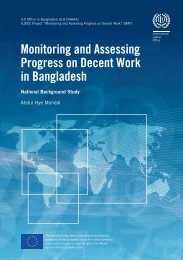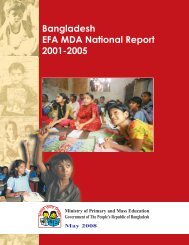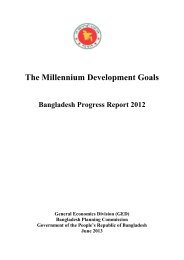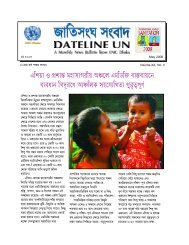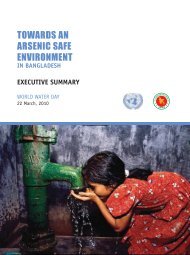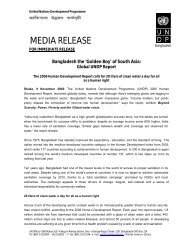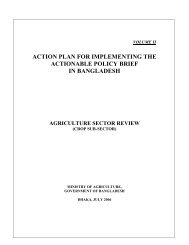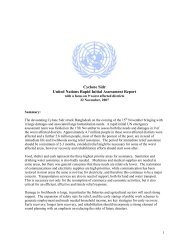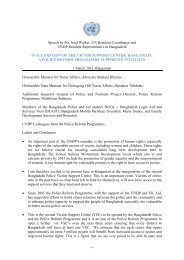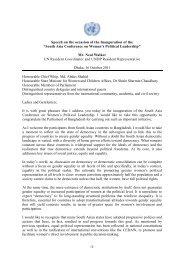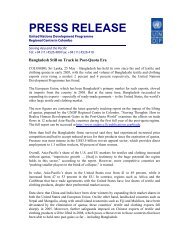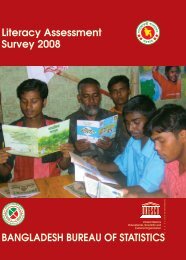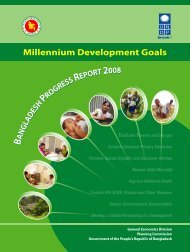Database - United Nations in Bangladesh
Database - United Nations in Bangladesh
Database - United Nations in Bangladesh
Create successful ePaper yourself
Turn your PDF publications into a flip-book with our unique Google optimized e-Paper software.
52 People's Report 2002-2003 : <strong>Bangladesh</strong> Environment<br />
Table 1.3.36<br />
Country Pesticide Dose 1 Appli<br />
cation 2 Simulium Control<br />
Reported effects<br />
Source<br />
Ivory Temephos 0.05-0.1 ppm/ H/FW Short term: massive detachment <strong>in</strong>vertebrate fauna Elouard,<br />
Coast 10m<strong>in</strong> Long term: disappearance/rarification of some species 1984a<br />
(Stimulium adersi) some Ephemeroptera proliferation of<br />
S. schoutedent, Chironomidae. No effect<br />
Hydropsychidae (predator of Simulium). 43%<br />
overall reduction quantity of aquatic <strong>in</strong>vertebrates.<br />
Ivory GH 74* 0.2 ppm/ G (*=OMS 1358= 1, 1-bis-(para-ethoxyphenyl)-2 nitro Troubat et. al.<br />
Coast 10m<strong>in</strong> propane). Very rapid and catastrophic <strong>in</strong>crease <strong>in</strong> drift Lardeux,<br />
of all taxa. Mortality of drift<strong>in</strong>g animals close to 95%. 1982<br />
Ghana Temephos 0.05-0.1 'by air' Increased drift of aquatic <strong>in</strong>vertebrates first hour after Sammon<br />
ppm/10m<strong>in</strong> spray<strong>in</strong>g. Afterwards normal drift cycles. No sign. and Pugh<br />
Reduction <strong>in</strong> normally drift<strong>in</strong>g populations<br />
Thamas,<br />
(Cladocera, Copepoda, Chaoborida). 1979<br />
(NB: very short observation period: 48 hours.)<br />
Source : Valk and Koeman (1988)<br />
Note<br />
_ Temephos Review article.<br />
Generally temephos at field rates <strong>in</strong>duced detachment Opong<br />
of <strong>in</strong>vertebrates from their substrates. Some groups -Mensah<br />
affected more (Ephemeroptera; Simulium sp.;). Others 1984<br />
<strong>in</strong>creased (spceically Chironomidae).<br />
Japan Temphos 5 ppm/30m<strong>in</strong> G Both <strong>in</strong>secticides killed the majority of the zoobenthos Yasuno<br />
Chlorphoxim 2 ppm/3 hours and resulted <strong>in</strong> a bloom of epilithic algae. The et. al. 1985<br />
chironomid populations recovered quickly but the<br />
trichopteran larvae slowly. (outdoor model stream study).<br />
Ivory Temephos 0.05-0.1 Alternate use of the 3 <strong>in</strong>secticides (but ma<strong>in</strong>ly temephos Elouard and<br />
coast Chlorphoxim ppm/10m<strong>in</strong> ? and chlorphoxim) dur<strong>in</strong>g 3 years, showed no difference Gibon, 1984<br />
Baillus (probably with the s<strong>in</strong>gle applications. No effect on population<br />
Thur<strong>in</strong>gieneis idem)1.6 ppm/<br />
densities as a whole.<br />
10 m<strong>in</strong> Change <strong>in</strong> structure: Ephemeroptera (Baetidae)<br />
H-14 H/FW decreased (esp. with chlorphoxim). Chironomidae<br />
<strong>in</strong>creased whatever <strong>in</strong>secticide is used.<br />
Togo Temephos 0.05ppm/ H/G Detachment of benthic fauna <strong>in</strong> gutters positioned <strong>in</strong> the Yameogo<br />
Azamethiphos 10m<strong>in</strong> river was 32-38% (azamethifos), 31% (temephos) and et. al. 1984<br />
0.17-0.2ppm/<br />
17% (control). Surber samples showed 42% detachment<br />
10m<strong>in</strong><br />
of fauna <strong>in</strong> situ azamethifos) Population structure was<br />
unaffected. Bulk of drift were Simultidae, Chironomidae,<br />
Ephemeroptera. (Short term experiment: 48 hours).<br />
Togo Permathr<strong>in</strong> 0.015 ppm/ H Detachment of benthic fauna 59-77%. Ephemeroptera Paugy<br />
10m<strong>in</strong> (94-98% detachment) and Simuliidae (89-100% det.) et. al. 1984<br />
were affected most. Chironomidae fairly <strong>in</strong>sensitive<br />
(6-29% det.) (all gutter experiments). In situ same<br />
pattern (surber samples).<br />
Concluded that short term effect of permethr<strong>in</strong> on nontarget<br />
aquatic fauna is far more drastic than temephos.<br />
: 1: All doses as active <strong>in</strong>gredient<br />
2: FW: fixed w<strong>in</strong>g aircraft application, H: helicopter application, G: ground application.



